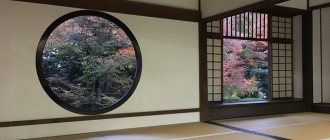Japan is a country in which, throughout its history, the transmission of traditions has never been interrupted, and there have been no successful attempts to differentiate into it significant elements of a foreign culture. The traditions of the Japanese are as unshakable as they are sometimes surprising, and they themselves are as modern as they are old-fashioned. And in this harmony there are no contradictions. It’s ridiculous to imagine bast shoes with a kosovorotka or a sundress with a kokoshnik in the Moscow metro, but a Japanese man in traditional national clothes looks organic even in an ultra-modern metropolis. This is a living history that invariably arouses genuine interest and surprise among the inhabitants of the European continent.
Why is Japan so protective of its traditions?
Europe was able to get to know this eastern country better not so long ago. For two and a half centuries, Japan was closed from the eyes and visits of foreigners. Probably because of this, European influence did not take over the ancient Japanese customs and culture of the people as much.
Since the 1600s, during the reign of Ieyasu Tokugawa, who finally united the country and headed the shogunate, there has been a long period of people being closed to foreign views.
Shogun Ieyasu Tokugawa
The ruler, although he maintained trade relations with different countries, was very biased and suspicious towards foreigners. It is known that since 1635, after the decree of the Supreme Leader, the Japanese were forbidden to travel outside the borders of their homeland, and foreigners were only allowed to stay on the island of Dejima.
Only in the Meiji era does the time of change and radical reform begin. It was then that, since 1868, a closed country emerged from isolation and became a large developing state. In a short period of historical time, it adopts all the innovations of the West, modernizes and improves. In turn, European peoples pay attention to the culture of Japan and introduce elements of the East into their culture.
Kimono for the Hina Matsuri holiday
This outfit in a traditional Japanese style is intended for very little fashionistas of the Land of the Rising Sun: one-year-old girls are offered to dress one-year-old girls in such soft pink silk kimonos.
This kind of clothing is bought at least once a year, before the Hina Matsuri holiday. This is a doll festival and is celebrated annually on the third day of the third month. The meaning of the holiday, which dates back to the Heian era - 8-12 centuries. - is to express my respect to all the girls living in the house.
© global.rakuten.com
A set of festive clothes for girls consists of a matching kimono, a long skirt and a head decoration that is attached with an elastic band.
On this day, noble families invited special snake charmers: they performed a complex ritual, after which it was believed that all troubles and bad weather would be transferred to paper dolls, which were made specifically for this purpose.
These dolls - nagashi-bina - were displayed on a special shelf located in the central room of the house. The dolls were then symbolically floated down the river. Today they look like a real work of art.
Rules of conduct and etiquette
First of all, let's talk about etiquette customs, since the Japanese are very respectful of etiquette rules.
The Japanese value hospitality. And here you need to know certain things so as not to offend a person. For example, handshakes are not accepted here, and bowing is considered the highest measure of respect for a person.
It can be used to express:
- greetings,
- parting,
- humility,
- apology,
- respect.
Residents bow when they meet, even if they have already met the person several times a day. You may notice that even while riding a bicycle, Japanese people often bow to each other.
Interestingly, the level of respect shown depends on the depth of the bow. They bow easily and not low to a stranger or unfamiliar person. This is a quick bow. This is how you greet a store clerk, a waiter, or a neighbor with whom you are not on friendly terms. Bows below are used for bosses. They bow very low when greeting the presidents of the company, and in personal relationships, people who are very respected by the Japanese: old people, people higher in rank and status.
The foreigner must also bow back to the Japanese. At the same time, looking directly into the eyes is considered offensive; you should look down.
Today, young people bow less often, replacing farewells with the word “bye.” This way, they can better emotionally express feelings of love for friends or sadness over a breakup.
Umbrella for rent
On almost any street in relatively large, and often small, cities, you can see a special vase-stand in which there are umbrellas. If the rain takes you by surprise, you can always use them. Umbrella rental is completely free, and the city practically does not incur the cost of purchasing new umbrellas to replace missing ones, because they always return to their place. The local population considers not returning them a shameful theft; they don’t do that here.
Communication
Despite the fact that the country has become one of the destinations for tourists, indigenous residents are extremely reluctant to meet foreigners. Communication often takes place through an intermediary, as they may feel uncomfortable talking to a stranger.
You should address a person by calling his position or surname with the prefix “san.” Calling your interlocutor simply by name is considered bad manners and is allowed only to those closest to you. Residents use the prefix “chan” when talking with children and close friends; they often pronounce it when calling their dog and other pets by name.
Of course, in recent years, adhering to these etiquette factors has become less of a strict rule. However, in formal situations, when addressing higher authorities and older people, traditions are still respected.
Delight
Walking around the city, you can always discover interesting places, and usually these are beautiful Buddhist temples, squeezed between houses or shops, sometimes hidden in the streets, which also have an amazing atmosphere. Spontaneous exploration of the area is highly recommended. Japan has many hidden treasures and interesting places, and there is always something new to discover. We can say that this is a country of endless delight.
In Japan, 80% of the territory is covered by mountains, and if you live in the Kansai region (cities like Osaka, Kyoto, Nara), it will be very easy to get to the most beautiful scenic spots by train.
Every season offers something special. For Russians who understand how they live in Japan, their favorite season is, of course, autumn. The incredible changes in leaf color in this state are impressive, and the best months for scenic beauty are November and October. In winter you can admire numerous views as well, and when it comes to the weather, in December and January the temperature does not drop below 5 degrees, February being the coldest. In spring, the cherry blossoms, which everyone probably knows about, attract many tourists. During the summer there are many traditional festivals and various events. As you can see, there is something going on all year round. Those who decide to personally find out how they live in Japan will not be bored.
Politeness
It is indecent to talk on the phone or talk too loudly in transport. A strong aroma of women's perfume, eating in a subway car or other public transport is considered disrespectful to others.
If a Japanese man who is older than you gives you a gift, you should definitely show your respect by touching his hands.
When speaking, it is impolite to look people in the eyes, cross your arms, or cross your legs. The correct thing to do is to look at the interlocutor's neck area.
Yawning, chewing gum and blowing your nose in public are considered the height of indecency here.
Before throwing away the napkin, you need to fold it carefully. In the country, the habit of order and cleanliness is instilled in people from childhood.
But it is not customary for the Japanese to give up their seat on public transport. This is due to the peculiarities of their mentality. The Japanese believe in karma, and when offering help, they do not want anyone to feel obligated to them.
Culinary delights
The taste preferences of the Japanese differ in many ways from generally accepted rules and traditions, as does their entire amazing life. Take these “oddities” for example:
- The most expensive products in Japan are considered to be fruits and melons. Buying peaches or apricots can cost $5 each, while the famous square watermelons can cost up to $1,000.
- Unlike Asians, hot spices are infrequent guests on Japanese tables. They consider them harmful to the stomach and replace them with their beloved soy sauces, of which there can be several dozen in everyday use.
- Due to the fact that meat was banned in the country for a long time, the methods of preparing it today are very different from classic recipes. Having placed an order in a restaurant, you may be very surprised to see “something” on the plate that only vaguely resembles beef or pork.
The Japanese literally shock tourists with their taste preferences. Well, where else can you find horseradish-flavored chocolate or carbonated tomato juice? And chips with raspberry flavor and Coca-Cola with cucumber flavor are a total brain blast.- Traditional rice vodka sake is not made from alcohol, as many people think, but from wort and malt. The production technology is very similar to beer, which also breaks all the patterns in the field of alcoholic beverages.
- It is not known why, but the Japanese have a tendency to paint products in unnatural colors. The simplest example is sushi. Everyone knows that pink ginger does not exist in nature; it is colored with special food coloring. The same “fate” befalls the caviar of flying fish, which itself is colorless.
Gestures
The Japanese love to use various symbolic gestures in their daily lives. For example, when taking pictures, the Japanese like to show a “V” with their fingers. They fold their hands in front of their chests and express their regret.
If a person touched his nose, then at the moment of speaking he meant himself. A gesture that in the West means “OK” here speaks of money.
If a man meets a lady in the evening, he can show his little finger. But in relation to girls, this gesture is considered vulgar.
The cult of the intimate side of life
They specifically relate to the topic of sex. Every bookstore has shelves with literature on this topic. In addition, Japanese art is replete with sex scenes. There was not a hint of a bad attitude towards sex in the ancient monuments of Japanese culture.
Cultural critic Yeneyame Toshinao says the tradition of openly depicting this topic has survived in literary works to this day because in ancient times sex was not considered an original sin, as, for example, in Christian culture.
Machismo
Gender discrimination in Japan is one of the country's biggest problems. This is not as important for the locals themselves as it is for foreigners. Discrimination against women is firmly rooted in the Japanese consciousness: in education, economics, politics, in a word, in everything! This happens due to the peculiarities of the history and traditions of this country during the times of the samurai. There are also no female politicians or company managers here. They have never existed in the history of this country and, probably, there is still a long way to go. Statistically, discrimination against women in Japan is almost comparable to the level in Muslim countries. This is a shocking fact, but this is the reality.
Food culture
The Japanese attach great importance to food culture and eating. Serving plays an important role. Dishes and special decorative decoration for a lunch or evening table are valued here. Before eating, be sure to wipe your hands and face with an oshibori napkin soaked in hot water.
All dishes are served immediately, but various utensils are also placed on the table at the same time as the food:
- braziers,
- alcohol lamps,
- spice sets,
- additional dishes.
Chopsticks should be placed on a special stand - “hashioki”. Under no circumstances should they be crossed or stuck into a bowl of rice during a meal - this gesture is associated with death due to the fact that this is how gifts are presented to the spirits of the dead.
You also cannot transfer food from your chopsticks to your interlocutor’s chopsticks. Buddhist custom says that in this way the remains of the deceased are transferred from hand to hand during burial.
A few quick interesting facts
- While we wear braces to straighten our teeth, Japanese youth ask dentists to have them crooked. Namely: make the fangs elongated and protruding forward. The procedure is not considered cheap and will cost the Japanese $500. However, the clinic plays it safe by performing the operation in such a way that the teeth can be restored to their previous appearance.
- Cleaning in schools, both in classrooms and throughout the building, is carried out by the students themselves. It is assumed that by caring for their place of work, the Japanese develop responsibility and hard work from childhood.
- In the country you can adopt an adult, mostly a man. This is often done by rich people and businessmen who do not have a successor, but need to pass the business on by inheritance.
- If a company fires a Japanese person, the company pays him a large penalty. Entrepreneurs have come up with an interesting move: they set up a so-called “idleness room” in offices or enterprises, in which workers are simply forced to do boring and useless work. After several months of such “laziness,” employees quit on their own, so the company does not have to pay them money.
- Workers in the service sector - taxi drivers, cleaners, porters, waiters - do not take tips. They will find it insulting if they are offered money. Thus, in Japan they believe that serving the client is a priori included in the payment for any service and additional money is not accepted.
- It is interesting to note that KFC cafe is very popular among the Japanese. For example, on New Year's holidays there are long queues in front of the cafe. Some residents reserve a place a couple of months in advance so that they can eat chicken wings and drink a glass of wine during this time.
- In Japan there is a very interesting job of "oshiya", or "pusher" in the subway. Due to the huge number of passengers on trains, workers literally have to push people into the cars. Therefore, part of the population prefers to get to their destination by bicycle, scooters or roller skates.
It is worth noting that the position of “pusher” exists in many eastern countries due to the large population in them.
- If you fall asleep at work, you can get praise from your boss. The point here is this: it is believed that if an employee falls asleep at work, then yesterday he stayed late at work and did not get enough sleep, which means he is completely devoted to the company and deserves encouragement.
The Japanese are big workaholics
It is customary to arrive to work half an hour earlier. They can work 12-15 hours without a lunch break. There is even a diagnosis of “karoshi” - death from overwork. Up to 10 thousand people die per year with this diagnosis.
- Top 10 natural disasters that threaten human life
- Obvious facts about incredible discoveries in science
- About the lucky ones of fate or how to become lucky
State pensions are low, so many Japanese work into old age. This is due to the fact that the Japanese are long-lived. They rank 4th in life expectancy, after Hong Kong, Iceland and Switzerland.
Unusual fear of having twins
The Japanese are afraid of having twins. One of them is believed to be from a demon. In the old days, they got rid of such children and the mother who gave birth to them. This theme is addressed in the Japanese anime When Cicadas Cry.
Currently, the birth of twins is tolerated. However, if a boy and a girl are born, this is regarded as an omen of trouble in the family.
In Japanese schools, twins study in different classes. Parents believe that for the successful development of intelligence and personality, each of the twins needs to have their own social circle.











